
Does the Press care more about migration than the public?
It’s been a busy couple of weeks in Migration World. The first asylum-seekers have moved on to the barge moored off Portland, much to the dismay of refugee campaigners and the local population. People are threatening legal action all over the place. The Sun has been on a tour and found a new resident who says it’s ok and another who says it’s good; the Mirror hasn’t been on board and has found an Iranian human rights lawyer who thinks it’s like going back to prison.
Meanwhile, the Mail has exposed “crooked” lawyers who are allegedly helping people to file fake claims, and the Home Secretary is going to crack down on them so that they – the lawyers, not the claimants – could face life in jail. An effective piece of work by the Mail; I bet campaigners on any number of other matters wish they could get such a concrete response from the government within two weeks.
The language used in discussing the subject remains toxic – to the point that we have the deputy chairman of the ruling party using Anglo-Saxon expletives to tell people who don’t like it to go away. It seems to have become a given that “the British people” want our politicians to “get tough” and that cruel rhetoric is not only acceptable, but desirable. Really?

“Stopping the boats” is one of the five pledges on which Rishi Sunak wishes the electorate to judge him. Politicians and press keep saying this has the “overwhelming support” of the British public, that it is the “will of the people” – while, at the same time, we are constantly reminded that “we are a welcoming country”.
They can say that all they like, but it is not clear that “stopping the boats” is what people want most. There may be concern that net immigration continues at record levels, seven years after the Brexit vote that was supposed to rein it in. There may be concern at the huge numbers of asylum-seekers who are being housed in hotels, hostels, old military camps, barges, tents and goodness knows where at heaven knows what cost. But is this concern rooted in the numbers, the cost, the plight of those in the system, or the failure of our officials to process these claims in a timely manner?
The latest Ipsos “issues” survey for July, shows that 21% of people questioned mentioned immigration as one of the most important issues facing the country. That placed it fourth, behind the cost of living, the NHS and the economy. It moved just ahead of the NHS to third in the list of “the most important” concerns, being cited by 9% of respondents. But the fact remains that four-fifths of people surveyed didn’t see it worth mentioning as a problem at all.
That is not to say it isn’t. Only 12% mentioned pollution, the environment or climate change; only 9% mentioned poverty and only 8% Brexit. Far more thought the performance of our politicians a greater worry – it being mentioned by 16%, against 15% citing housing.
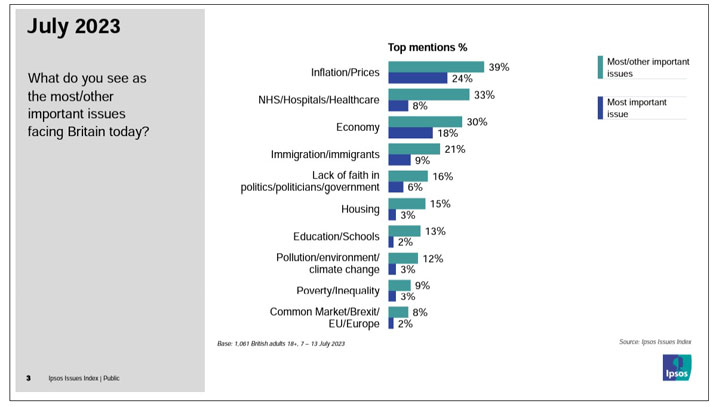
It seems to me there are two ways that issues are going to fight their way on to this league table: personal experience and what the mainstream media report on. It’s no surprise that prices are at the top; most people are feeling the pinch. The health service is always up there; we all need doctors and hospitals and all know of people who have had to wait ages for treatment or who can’t get through to the GP.
But after that, it’s the subjects that make the news agendas that come to mind when the pollster comes to call. If politicians, press and broadcasters focus on something, it goes up in the public consciousness.
Those politicians and journalists will say that they respond to what they hear on the doorstep, what readers tell them. But they also listen to vested interests and lobbyists and can cherrypick the issues they want to deal with. They can, and do, pursue and advance causes and policies that wider public hadn’t asked for, identifying “problems” that didn’t exist – electoral fraud and voter ID anyone? – while ignoring genuine irritations, like the difficulty in getting from A to B smoothly.
Before the 2015 general election, the percentage of people mentioning Europe as an important issue was in single figures. Nigel Farage and Eurosceptic Conservatives, aided by the Press, turned it into a big issue and by the time of the referendum it – and immigration – were right up there at the top with the NHS. Now you could say that was a case of people having something they needed to know brought to their attention; that the Press was doing its job. I might not agree, but that’s not the point.
For now, we’re told that global warming predictions are scaremongering and that we can’t afford measures to tackle climate change; levels of poverty and food bank use are massively under-reported; and no one in the mainstream dares mention Brexit, other than to report assertions that it’s all going to be wonderful one day. No wonder these all languish at the bottom of the league.
Did no one mention infrastructure? Roadworks, potholes, trains? Rivers flowing with sewage? They all get sporadic coverage, but not the day in, day out hammering in the press that pet subjects such as wokeness and gender wars attract. In fact, neither of those favourites warrants a mention in the Ipsos survey either. I’d like to say it’s because they don’t matter to people as much as newspapers would suggest – which is what I happen to believe. But I must also concede that blows a hole in my main argument about how far political and press agendas influence what people think and care about. It clearly can’t be all one way, there has to be a meeting of minds.
The question is, do those minds meet with the boats? We must stop the boats. Of course we must stop the boats, people are putting their lives at risk with dangerous crossings, enriching smuggling gangs in the process. But that doesn’t seem to be the message being conveyed by most of our newspapers. Instead, they are selling an “us and them” story; one that is far more preoccupied by the inconvenience to “us” than the dangers to “them” – dangers reinforced by the deaths of another 41 people in the Med yesterday.
For those papers, the Government’s chosen solution is the right one and to oppose deporting boat people to Rwanda (or, for five minutes this week, to Ascension Island) is unrealistic, unpatriotic and undemocratic. For the other side of Fleet Street, the strategy is cruel, inhumane and impractical. Migration might be on the minds of 21% of people taking part in that Ipsos survey, but who is to say which camp they fall in?
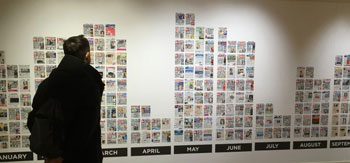
As I have written here before, I started monitoring “migrant” front pages ten years ago, and wrote about the coverage for InPublishing in 2016. That year I compiled what I called the “Chart of Shame”, which was turned into an installation for the Migration Museum in London. It seemed to me that refugees, asylum-seekers and economic immigrants were all being bundled together under the “migrant” banner and being weaponised to forward the case for a Leave vote in the referendum. The Daily Mirror splashed on migrants just the once, the Daily Express 72 times.
Now here’s a bar chart showing the number of migrant splashes this year from the national dailies, paired with their Sunday sisters, set alongside the totals for 2016. With a tally standing at 35, the Express has already carried more this year than anyone else, apart from the Mail, did in the whole of that high-point referendum year.
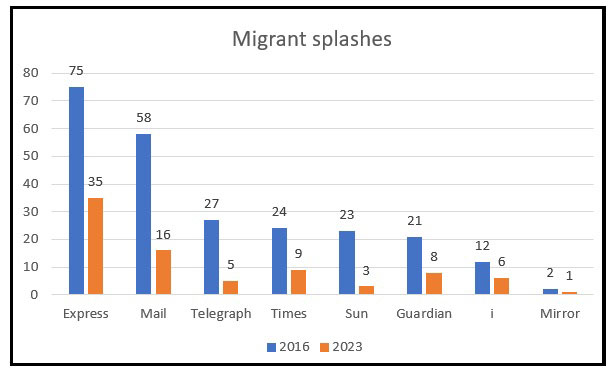
In 2018, the Express’s incoming editor Gary Jones said that some of those old headlines gave him sleepless nights. I wonder how he’s sleeping now.
Women play football too
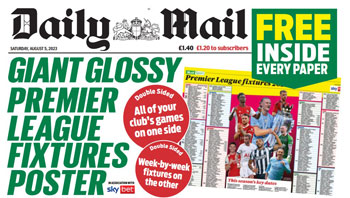
What’s going on at the Daily Mail? Football? Football!
The top half of last Saturday’s front page was given over to a GIANT GLOSSY PREMIER LEAGUE FIXTURES POSTER that was FREE INSIDE EVERY PAPER. This was a super special poster because it was double sided – all of your club’s games on one side and the week-by-week fixtures on the other. Which one to pin to the wall? Decisions, decisions. In fact, it was so special that promoting it took up the top half of the back page as well.
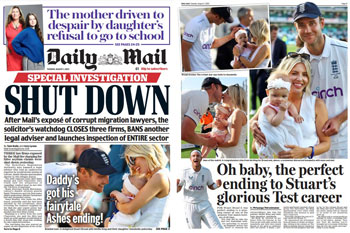
This isn’t the way it’s supposed to be. A bit of purple and green for Wimbledon, a bit of celebrating when British teams or athletes do well, and maybe a picture of a sportswoman looking particularly fetching (or dishevelled). By and large – unless it’s Andy Murray – it’s the photogenic women playing or watching rather than the sport that matters. The photograph to mark Stuart Broad’s spectacular farewell performance in the Ashes ran absolutely true to form. Not the arms-aloft final wicket shot preferred by most papers (other than the Telegraph, which went down the same road), but one of Broad with his partner, the Saturdays singer Mollie King, and their cute little daughter. The paper was so enchanted with the family that it also made a picture special for page 3.
And then this. Football? Dominating the front? How plebby can you get? Or maybe it has woken up to the idea that it might sell papers?
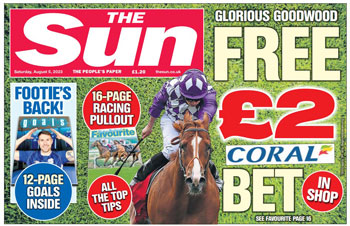
The Sun certainly thinks – or rather knows – it does. Although perhaps not as many as horseracing. Its Saturday front was mostly about Glorious Goodwood, but tucked in with it was a little puff for the Goals supplement. There were two things that were a bit odd about this.
First, rather than going the conventional route of reproducing the supplement cover, it featured a photograph from an inside spread of Aaron Ramsey of Cardiff. He may be the Welsh captain, but, with all due respect, not the most recognisable player to sell the paper.
And second, the headline “Footie’s back”. Well, the supplement is back. The Championship and EFL started over the weekend. Arsenal and Manchester City played the traditional curtain-raising Community Shield match on Sunday. But “footie” has been in full swing for a couple of weeks now. There’s this competition going on called the World Cup and at the time England were doing rather well.
But they’re women. It’s not proper footie, is it? Lauren James made a little bit of the page one puff with a pointer to “sport” after England beat China 6-1. She was, indeed, on the back page, but again as a puff. The lead was speculation about Harry Kane. You had to go back five pages before you reached a report on the women’s match.
OK, the Premier League is where it’s at. And every football fan wanted to know whether the England captain would be playing in it or in the Bundesliga when the season gets underway tomorrow. But I do think our sports editors are a bit slow on the uptake with regard to the interest in women’s sport, particularly cricket and football.
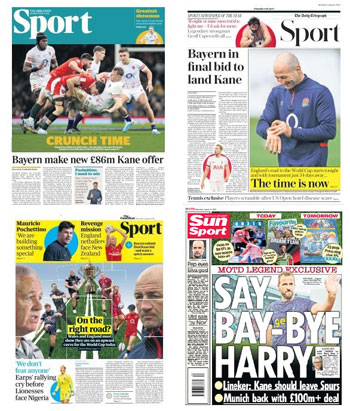
For the Sun is not alone. Take the Telegraph’s sport supplement last Saturday. The lead was Harry Kane, the picture England rugby coach Steve Borthwick on that day’s test against Wales, and the puff Geoff Capes (remember him?). The only women to feature in the entire supplement were in Emma Hayes’s comment column on the World Cup.
Unless you count the wraparound – four pages on the Lionesses, with the headline “The world is watching”. National newspaper advertising wraparounds don’t come cheap. Xero will have thought it was capturing the mood with its effort. And it produced evidence to support that perception. The inside spread was full of statistics on the growing interest in women’s football, which had accelerated since the Lionesses won the Euros. There are now 2.5m registered female players in England, there has been a 30% increase in the number of registered female teams; the three highest attendances at any European football matches last year were all for women’s games, with the England v Germany Euro final coming in third with a gate of 87,192.
I wonder if the sports editor of the “Sports newspaper of the year” bothered to look at what went out around his efforts.
Over at the Times, Kane and rugby were also top of the bill, with Stuart Broad in the puff. Inside, the first three spreads were given to the rugby World Cup warm-ups before moving on to football. The women got their first look in on the last three columns of the second spread, ahead of a match report on Southampton (men) winning their first game in the Championship. There was a good feature on the Kenyan runner Faith Kipyegon aiming for a four-minute mile, but England’s Roses preparing for the netball World Cup semi-finals had to share half a page with Katie Archibald’s “blistering” return to Glasgow and her team’s hopes for gold in the cycling world championships.
The Guardian alone had women on their sports section cover – Mary Earps talking about England’s World Cup chances and a netball puff – before joining the crowd focusing on the rugby and the imminent football season. There was a page for each of the two women’s World Cup competitions as the paper devoted about a quarter of its total sports coverage to women – about the same as the i. That was a huge proportion compared with the rest: of 550 columns of sport across the whole of Fleet Street that day, 59 were about women. The Sun, which had by far the most sport space at 100 columns, managed six for the women.
The Sundays were split between the rugby inquest for the heavies and the Community Shield preview for the redtops – with a bit of Kane to leaven the mix. The Roses had become the first England team to reach the netball World Cup final – to be played in Cape Town that day – but you had to search hard to find mention of them. Where were the pre-match build-ups, the profiles, the analysis? Nowhere.

On Monday, every paper bar the Mail and Express had football on the front page. The redtops (which all also had racing) and the i took the “It’s back” approach, focusing on the Community Shield. The FT, Guardian and Times went for America being knocked out of the women’s World Cup – the Guardian going for a quarter-page picture of Sweden’s Lina Hurtig celebrating after scoring the winning penalty, without troubling to name her. Metro and the Telegraph looked forward to the Lionesses’ match that morning, in the Telegraph’s case by using Lauren James as the main photograph. Bad luck there. The Mail, meanwhile was an outlier with a picture of a disappointed England netball player. Well done to them for noticing the competition. The Sun was not alone in catching up with the tournament only after it was over – and then reporting it deep in the sports section between the racing and acres of men’s football.
On Tuesday, only the FT denied the Lionesses a spot on the front - kudos to the Telegraph for using a picture of Lauren James and that “stamp” at the top of its “INSIDE” panel, while everyone else went for the celebratory shots. I liked the Mail’s “Lionesses claw their way…” headline and also the Sun’s so-straight-it-tells-you-more-than-it-seems “England win on penalties”. It wasn’t necessary to hammer it home with “Lionesses show the lions how to do it”.

Many, including the Sun and Mirror, had news spreads, but what about the sports pages? While most led on the women scraping through and James’s Beckhamesque “moment of madness”, all three redtops stuck with the tried and tested to splash on the men’s game – Mo Salah not going to Saudi Arabia and concerns about new time-wasting rules that make matches last forever. At least James made the top of the Sun and Star back pages. She was just a puff for the Mirror.
This seems likely to be the pattern for as long as the Lionesses survive in the competition: plenty of room up front, but playing second fiddle at the back.
My point is not that the papers were wrong to major on the Premier League and the rugby on Saturday; they clearly weren’t. They will say that they know their market, that it’s what sells, that it’s what readers care about. But readers are also interested in sports other than football and in players other than men.
As the Telegraph’s Xero wraparound showed, all the evidence points to a huge developing interest in women’s football. But, even after England’s Euros win, our sports editors are behind the curve. There are millions playing and hundreds of thousands willing to pay to watch (not least because it’s cheaper to get in and a more salubrious atmosphere in the stadium); broadcasters give the game more and more airtime. Yet still our newspapers seem to regard female footballers as wannabes to be humoured, rather than taken seriously; their place is to adorn the news pages if they do well, not to threaten the supremacy of the "real" sportsmen on the back pages.
Time to wake up, I think.
What do two yellows make?
The Sun is not only preoccupied with the Premier League, it has a habit of becoming fixated on particular players and what they get up to off duty. The current favourite for this attention is Jack Grealish. I’m not going into the ethics or news judgments that brought readers this full page this morning – watching and photographing a car for four hours? – but who could help but smile at the headline? Football pedants might quibble that the price of two yellows is a red, not a penalty. But, hey! Nice one.

What constitutes front page news at The Times?
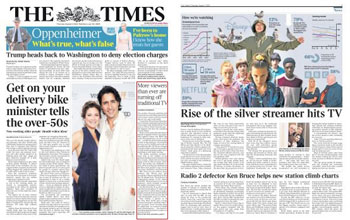
More viewers than ever are turning off traditional TV, according to a Times front-page headline last Thursday. Well we’ve known for yonks that streaming networks are in the ascendency, haven’t we? So let’s look at what’s so remarkable about these new figures that they are worthy of one of four slots on what was once the world’s greatest newspaper’s showpiece page.
Ah! the number of people watching “broadcast” television has fallen below 80% for the first time. It’s the sharpest fall since records began.
Fall from where? Ah! again. It’s down from 83% in 2021 to 79% last year. A huge change.
And when did these records begin. Ah! for a third time. Ofcom has been publishing these reports since 2017. So the biggest fall in six years.
There are other figures in this report, too. Like the fact that people watch an average of 4 hours 28 minutes of television a day, more than half of it “traditional” fare. And that 58% watch BBC One, which “continues to have the highest reach of all TV channels”, streamed or broadcast, terrestrial or satellite. That last was in the big graphic on page 5, but didn’t feature in the text, either on the front or in the inside page lead, which homed in (probably rightly) on the surge in the number of older people turning to Netflix, Amazon and Disney; “silver streamers” as they were inevitably christened.
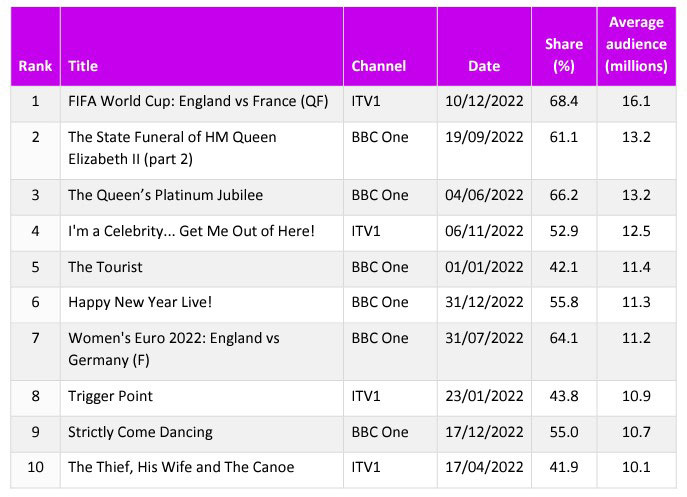
Ofcom also provided interesting sidebar / panel fodder with a list of the ten most-watched programmes last year. These were all mainstream terrestrial broadcasts, with ITV’s coverage of the England v France (men’s) World Cup quarter final topping the list, perhaps surprisingly beating both the Queen’s jubilee and her funeral (third and second, respectively). BBC One took six places against ITV’s four. It’s an intriguing mix of sport, royalty, reality and a little bit of drama. So intriguing that I reproduce it here. Who’d have thought The Tourist would come in at number 5?

Look how many people wanted to see Matt Hancock eat witchetty grubs on the opening night of I’m a Celebrity – except, in spite of the hype and hubris of the previous week, he didn’t arrive until later. The Sun did a spread the next day saying ITV bosses had “splurged” £2.1m on big-name contestants as a “worthwhile investment”, hoping people would tune in on day one and stick with it. The strategy seemed to work, the series averaged 11m viewers per episode.
All this was an interesting snapshot of a moment in a trend of which we’re all aware. Most papers reported it in a couple of hundred words inside - older folk developing a liking for Disney; soaps losing their drawing power – and it made a page lead for the Telegraph (page 9) and Mail (page 26). The Times’s page 5 whistles-and-bells treatment was nicely done, but that 79% was really just a dot on a sliding fever-chart line and never worth the front.
Unless you were seeking a fresh way to take a subliminal dig at the BBC. In which case, Radio 2 losing a million viewers after Ken Bruce’s move to Greatest Hits (reported in the basement on page five) would have done nicely.

“But what would you have put on the front instead?” might be a reasonable riposte to the above. To which one answer might possibly have been the prime minister appearing on a radio phone-in covering a range of subjects. Including the admission that one of his MPs, a former cabinet minister no less, is failing to do her job.
Rishi Sunak’s appearance on LBC made the splash for the Express (“Rishi’s blunt ultimatum to striking doctors”), the Mirror (“Yeah, right”, “Rishi: NHS strikes are to blame for waiting lists”) and Metro (“Election won’t be Soonak”). As we see from the Express / Mirror contrast (the Reach stablemates may have disagreed about the PM, but shared the same Tesco ad), there was plenty of material here for both the “pro” and “anti” camps. The Telegraph had a little bit on Nadine, the Mail an even littler bit on small businesses, while the Star ripped into “Biggles” over his performance on just about everything.
And The Times? The Times did the best of the lot. It turned the broadcast into an opportunity to conduct an end-of-term assessment of the prime minister’s performance, with particular emphasis on his “five missions” (sorry, I think Starmer has five missions, Sunak has five pledges). This was instructive, as the Thunderer is quite supportive of Sunak. It realises that hopes of a Tory victory at the next election are slim, but it is ever willing to give him advice on how to make the best of a bad fight. The resultant report card suggests he still needs to get some training in before the big match. His highest score was 3/5 on the cost of living. After that it was downhill all the way: 2/5 on the NHS, climate change and small boats, and 1/5 on Dorries, where Steve Swinford and Oli Wright point out that he has the power to strip her of the whip. “This he has not done.” Damnation in five words.
A taster of that on the front would have been so much better than fewer people watching live TV.
Are some forms of racism more acceptable than others?

Am I being unfair to The Times? Very possibly. Three out of four isn’t bad. The Trump indictment should have been – but wasn’t – a no-brainer for everyone, the Trudeaus splitting a reasonable picture, and the splash on Mel Stride telling older people to get on their delivery bikes was a good story with a smart headline (so good the Mirror splashed on it the next day).
Compare that with the Telegraph’s “big four” that day. It also had a single minister splash – in this case the Welsh Secretary being investigated by police over a campaign flyer – the Trudeaus in the picture slot, a double on record numbers of people taking out “lifetime” mortgages – pertinent on the day the Bank was expected to raise interest rates again – and a three-column “debanking” story on hunts being banned from taking card payments. I struggled to feel for Nigel Farage. But how many tears are going to be shed across the country if people who go hunting and shooting can’t use plastic to pay their dues? Meanwhile, Trump was a nib – as were the silver streamers.
The tone of that splash on the police investigation into the campaign leaflet, which was about proposals for a travellers’ site in his Monmouth constituency, was entirely sympathetic to David Davies, and invoked previous remarks by Suella Braverman that police should be focused on “real” crimes, rather than things that merely upset people. That’s a view many – even among the “wokerati” – would sympathise with.
So what did the leaflet say? It was titled “Gipsy and Traveller Site Coming to Your Area Soon!” and a “have your say” questionnaire on the back included, “Would you like to see a traveller site next to your house”. Davies said it addressed legitimate concerns and that even the traveller community was unhappy about the proposals from the Labour-controlled council. But a project manager for a charity that gives advice to Roma and travellers said: “You really would only have to substitute the words ‘gipsy and traveller’ for any other ethnic group and you would see that it is racist.”
There is no doubt that there should be proper consultation with the local community before any big developments go ahead. And there’s always a difficult line between justifiable concerns and nimbyism. But the story drove me to look back at the 1964 general election and Patrick Gordon Walker’s defeat in Smethwick, thanks to what is universally accepted now as a racist campaign by the Conservatives.
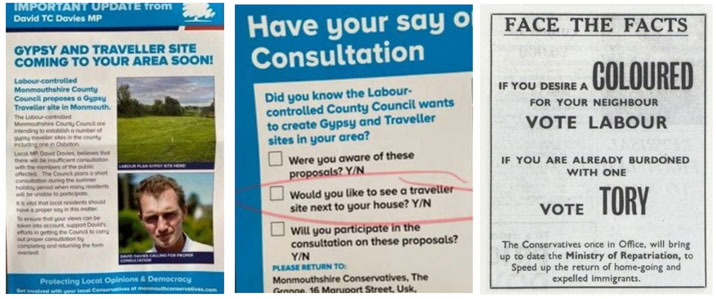
Here are the two flyers, nearly 60 years apart. The election poster would never be tolerated today. But have we moved on quite far enough?
Home truths
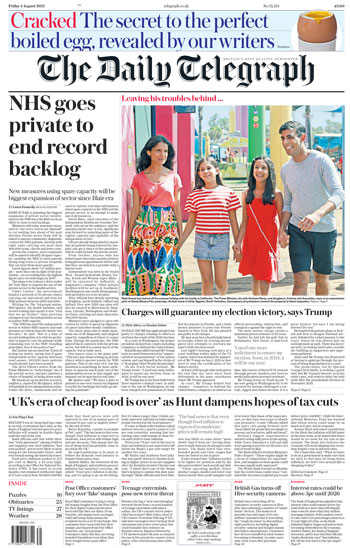
There was a phrase during the Troubles of the 70s and 80s to justify the conscious decision not to report some incidents. Terrorists (by which politicians and press usually meant the IRA rather than UDA) had to be “denied the oxygen of publicity”. There was a logic to this, particularly in the reporting of bomb hoaxes that might encourage copycats and not only cause disruption to the general public, but distract the security services from real threats.
I had a sense of that philosophy in the coverage last week of the Greenpeace demo at Rishi Sunak’s Yorkshire home. It was absent from The Times, i, Mirror and Sun front pages and all but invisible from the Telegraph, whose main image was a holiday snap of the Prime Minister’s family with a “by the way…” mention of the demo in the two-line caption. The headline over the photograph was, “Leaving his troubles behind”.
If you want to irritate a demonstrator, ignoring them is probably the best way to do it. But this wasn’t a story about “yet another” climate change protest. It was a story about a monumental breach of security. About how the Prime Minister’s home is so inadequately protected that a group of people in orange boiler suits and hard hats could spend hours climbing ladders on to the roof and swathing the property in black fabric before anyone took any action.
Whether you are of the right or left, this wasn’t a question of what they were demonstrating about or about the new anti-protest laws. It was about security. And as such it was an important incident worthy of proper attention. The Times and Telegraph may have made a conscious decision not to give Greenpeace the satisfaction of putting photographs of their stunt on their fronts – fair enough, I guess – but the happy holiday picture and Trump getting off a plane looked lame. And surely The Times could have found room for the security breach in the nibs at the bottom, perhaps instead of the latest on turning an airbase into a refugee camp or advice that patients should walk around hospital wards to get them ready for discharge?
The paper did, in fact, run four pictures from Richmond in a tint panel on the politics spread inside. And the headline on the little story accompanying the photographs was about what the activists did and why, rather on the security issue. So the protesters got their publicity, if not the prominence. Over at the Telegraph, there was a big picture of the black-wrapped building and a page lead headlined “Anti-oil activists invade Sunak family home”, which at least got a bit of the sense that this was more concerning than just any old stunt. The writers of both of these stories made the security breach their intro (weirdly, in The Times, by framing it round what Priti Patel thought Suella Braverman should be doing). They got it. But, with their presentational choices, the backbenchers and production teams staged a demonstration of their own – in missing the point.
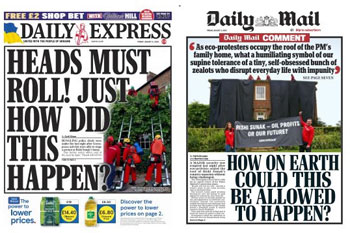
At the other end of the scale came the whitetop tabloids and Metro, which all splashed the protest. “Heads must roll”, shouted the Express. “How on earth could this be allowed to happen?” demanded the Mail. “Despicaboil” spluttered Metro. The Express had bungling police chiefs having questions to answer and the Mail a major security row erupting. So they got it.
At the risk of banging this drum so loudly, the reason this was an important story was not what the protesters did, but that they were able to do it where and how they did it.
But the fact that they were part of the “eco-mob” meant it so much more exciting for papers like the Mail, which found itself with two easy targets at which to fulminate across five pages, including a full-page leader.
Deafening silence continues
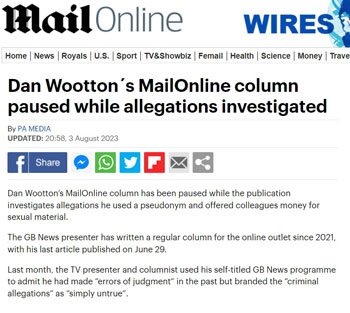
Of course, if you wanted to stop them doing it again, you’d do that “denying the oxygen of publicity” thing, report the security breach and not name the organisation or their cause. But that would be pointless in this day and age. It would be out there on social media; broadcasters and other titles would name them and you’d just look stupid.
I mean there’s no precedent for not reporting stuff that’s all over the internet or in lower-circulation newspapers; stuff like one of your online columnists being the subject of a string of sexual, bullying and coercion allegations. The Mail has now suspended Dan Wootton’s column, pending an internal investigation. But it still hasn’t printed a word about the claims against him in the paper. It has, however, run a PA report on the suspension in the Wires section of the website.
Maybe that’s because it is in no position to stand up or refute the allegations. But didn’t that apply also to Huw Edwards? Yet, in the four days up to and including his wife naming the newsreader as the man at the centre of the “sex photos” storm, the Mail ran 14,631 words on the “scandal”. These included half a dozen stories and leaders about the BBC being in meltdown and its responsibility as an employer to put its house in order.

Telegraph not communicating
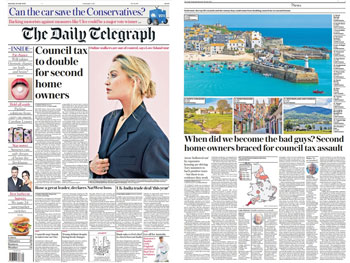
Don’t they have editorial conferences at the Telegraph? Don’t the supplement people talk to the newsdesks about their weekend goodies?
Here’s the paper’s splash and inside feature from a couple of Saturdays ago. Horror, horror! Council tax to double for people with second homes. This is outrageous.
And here’s the front of the Money section: Hurrah, hurrah! The extreme weather in Europe is giving a boost to the staycation market. Buy-to-let is a pain, so why not buy-to-holiday-let instead. There are a couple of downsides, one of them being the risk of having to pay more council tax. But it’s not a big deal, just something to be covered at the bottom of the story on the page 2 turn.
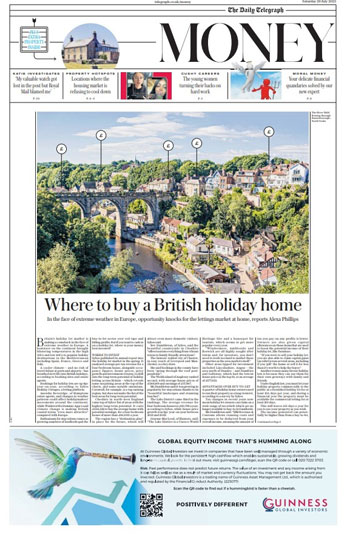
Front page of the fortnight (two for the price of one)
The runner up:
I’m tired of the constant attacks on the Duke and Duchess of Sussex. I hate the snide remarks about everything they do. Over the past couple of weeks, we’ve had sneering at Meghan’s birthday celebrations, schadenfreude over Netflix apparently becoming less enchanted with the couple, and speculation that Harry is unhappy and that the marriage is faltering.
But if you’re going to pursue this obsession, this is the way to do it. It’s a good story (assuming it’s true), well presented. This is why The Sun is excused putting the Sunak home invasion story on page 19.
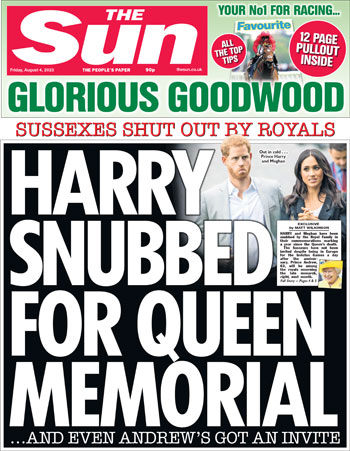
And the winner:
Meanwhile the Mirror came up with another of its go-it-alone “issue” covers (and a good spread inside) to highlight what happens to some of the clothes we give to charity shops in the expectation that they’ll be sold and worn here in the UK. We’ve seen others tackle failures of recycling, where plastics (including some in my supposedly green local council’s see-through sacks) end up in some far-off ocean or washed up on island beaches, but this was a new one on me.
There is much more to be written on how we dispose of unwanted stuff that is “too good to throw away”. Charity shops aren’t municipal skips, but it’s hard to come to terms with the notion that nobody wants our cast-offs, that no shop needs a zillionth copy of The Da Vinci Code because anyone interested in reading it has already done so.
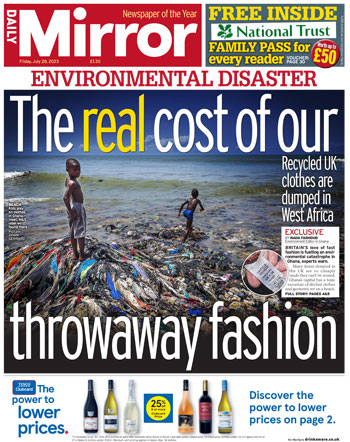
Liz Gerard’s Notebook is a fortnightly column published in the InPubWeekly newsletter. To be added to the mailing list, enter your email address here.












